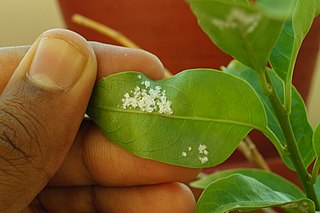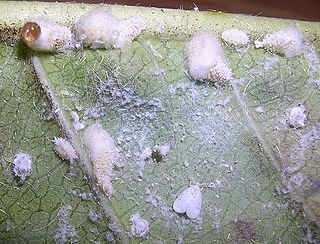
Hemiptera is an order of insects, commonly called true bugs, comprising over 80,000 species within groups such as the cicadas, aphids, planthoppers, leafhoppers, assassin bugs, bed bugs, and shield bugs. They range in size from 1 mm (0.04 in) to around 15 cm (6 in), and share a common arrangement of piercing-sucking mouthparts. The name "true bugs" is often limited to the suborder Heteroptera.

Whiteflies are Hemipterans that typically feed on the undersides of plant leaves. They comprise the family Aleyrodidae, the only family in the superfamily Aleyrodoidea. More than 1550 species have been described.

Scale insects are small insects of the order Hemiptera, suborder Sternorrhyncha. Of dramatically variable appearance and extreme sexual dimorphism, they comprise the infraorder Coccomorpha which is considered a more convenient grouping than the superfamily Coccoidea due to taxonomic uncertainties. Adult females typically have soft bodies and no limbs, and are concealed underneath domed scales, extruding quantities of wax for protection. Some species are hermaphroditic, with a combined ovotestis instead of separate ovaries and testes. Males, in the species where they occur, have legs and sometimes wings, and resemble small flies. Scale insects are herbivores, piercing plant tissues with their mouthparts and remaining in one place, feeding on sap. The excess fluid they imbibe is secreted as honeydew on which sooty mold tends to grow. The insects often have a mutualistic relationship with ants, which feed on the honeydew and protect them from predators. There are about 8,000 described species.

The silverleaf whitefly is one of several species of whitefly that are currently important agricultural pests. A review in 2011 concluded that the silverleaf whitefly is actually a species complex containing at least 40 morphologically indistinguishable species.

Woolly aphids are sap-sucking insects that produce a filamentous waxy white covering which resembles cotton or wool. The adults are winged and move to new locations where they lay egg masses. The nymphs often form large cottony masses on twigs, for protection from predators.

Trialeurodes vaporariorum, commonly known as the glasshouse whitefly or greenhouse whitefly, is an insect that inhabits the world's temperate regions. Like various other whiteflies, it is a primary insect pest of many fruit, vegetable and ornamental crops. It is frequently found in glasshouses (greenhouses), polytunnels, and other protected horticultural environments. Adults are 1–2 mm in length, with yellowish bodies and four wax-coated wings held near parallel to the leaf surface.

Psylla pyri, commonly known as the pear psylla or pear psyllid, is an insect in the family Psyllidae. Originating in Europe and Asia, it has spread to North America. It is a pest of pear trees, sucking the sap, damaging the foliage, flowers and fruit and diminishing the crop.

Aleurocanthus woglumi is a species of whitefly in the family Aleyrodidae. It is a pest of citrus crops, and is commonly known as the citrus blackfly because of its slate-blue colour. It originated in Asia, but has spread to other parts of the world. The parasitic wasps, Encarsia perplexa and Amitus hesperidum can help control the pest.

Paracoccus marginatus, commonly known as the papaya mealybug, is a small sap-sucking insect in the mealybug family, Pseudococcidae. It is found on a number of different hosts, including economically important tropical fruit trees and various ornamental plants.

Metcalfa pruinosa, the citrus flatid planthopper, is a species of insect in the Flatidae family of planthoppers first described by Thomas Say in 1830.

Coccus hesperidum is a soft scale insect in the family Coccidae with a wide host range. It is commonly known as brown soft scale. It has a cosmopolitan distribution and feeds on many different host plants. It is an agricultural pest, particularly of citrus and commercial greenhouse crops.

Eriosoma lanigerum, the woolly apple aphid, woolly aphid or American blight, is an aphid in the superfamily Aphidoidea in the order Hemiptera. It is a true bug and sucks sap from plants.

Pulvinaria regalis is a species of scale insect in the family Coccidae. Although it is commonly known as the horse chestnut scale, it affects other trees besides horse chestnuts as well as many species of woody shrubs. Adults are normally all female and produce eggs by parthenogenesis. The insects are thought to have originated in Asia but arrived in Europe in the second half of the twentieth century.
Pyrilla perpusilla, commonly known as the sugarcane planthopper, is a planthopper in the family Lophopidae. It is native to Asia where it feeds on grasses and other plants and is a major pest of sugarcane and sorghum.

Phenacoccus solenopsis, the cotton mealybug or solenopsis mealybug, is a species of mealybug in the family Pseudococcidae. Having originated in North America, it has spread to other parts of the world and become a major pest of cotton crops.
Aleurotrachelus atratus better known as the palm-infesting whitefly is an invasive species that affects coconut palms. Originally, this species was only prevalent in Brazil and was known to feed on coconuts native to this country. Now, the species has migrated to the tropics and subtropics and is invasive in many other countries. Aleurotrachelus is one of the largest genus, containing 74 species.
Aleurodicus cocois, commonly known as the coconut whitefly, is a species of whitefly in the family Aleyrodidae; it feeds on coconut and other palm trees in South America and the Caribbean region.
Axinoscymnus puttarudriahi, is a species of lady beetle native to India and Sri Lanka.

Planococcus ficus, commonly known as the vine mealybug, is a species of mealybug, belonging to the family Pseudococcidae, native to tropical and subtropical regions. The vine mealybug is found in Europe, Northern Africa, Southern Africa, the Americas, and the Middle East. The vine mealybug is invasive to weedy plants in many different regions of the world.

Orchamoplatus citri, commonly known as the Australian citrus whitefly, is a whitefly species in the genus Orchamoplatus. It is found across Australia and New Zealand, primarily foraging on the leaves of citrus trees.
















